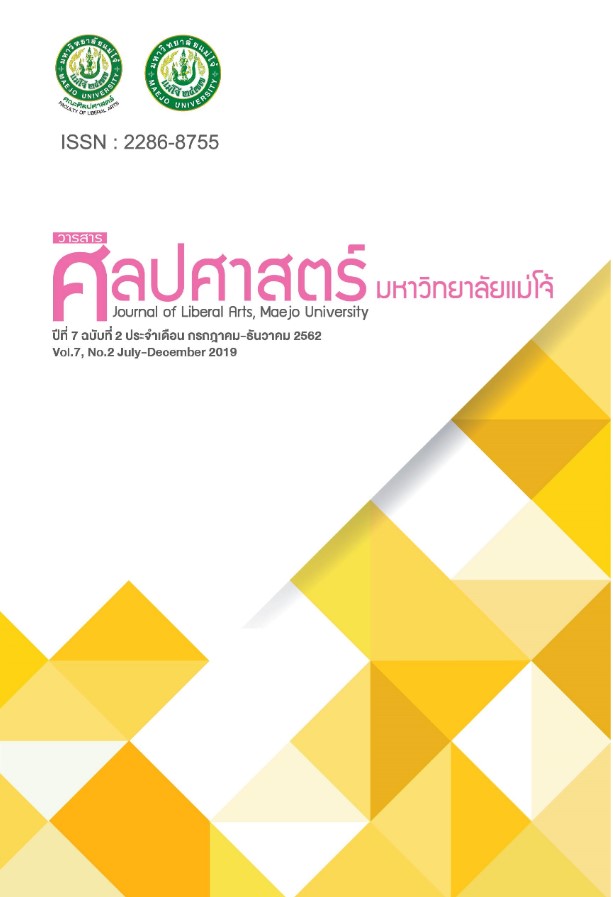Types of Epithet Origin and Epithet Formation of Thai Stars from 2010 to 2018
Main Article Content
Abstract
This research aimed at analyzing origins and types of epithet formation of Thai stars. Data were collected from www.sanook.com and www.mthai.com from 2010 to 2018. A number of epithets found during this period were 90. They were analyzed and the findings were presented in a descriptive method with statistics. The research indicated that the origins of Thai stars’ epithets can be categorized into eight types: performance or careers, words describing characteristics of referred stars, names, achievements, behaviors, places of birth, status, and body parts. The type of origins of Thai stars found in the highest frequency was behaviors whereas the type of origins of Thai stars found in the least frequency were places of birth and body parts. In terms of epithet formation, there were three types, namely epithets formed by one origin, two origins, and three origins. There were 27 epithets formed by one origin, and they were sub-classified into 5 types. Regarding epithets formed by two origins, there were 60 epithets, and they were sub-classified into 12 types. For epithets formed by three origins, there were three epithets, and they were
sub-classified into 2 types. The most epithet formation found in each type was 1) epithets created by the stars’ behavior 2) epithets created by words describing characteristics of referred stars and their behavior and 3) epithets created by the stars’ performance or careers, names, and achievements respectively. Considering three types of epithet formation, it was found that the epithets formed by two origins occurring in the largest proportion whereas epithets formed by one origin and three origins were ranked second and third respectively.
Article Details
References
รัชนีกร รัชตกรตระกูล. (2559). มิใช่เพียงแค่ฉายา : สมญาดารากับอำนาจของสื่อในการวิจารณ์ พฤติกรรมและสร้างภาพตัวแทนบุคคลในวงการบันเทิงไทย. วารสารไทยศึกษา, 12(2), 108-111.
ราชบัณฑิตยสถาน. (2556). พจนานุกรม ฉบับราชบัณฑิตยสถาน พ.ศ. 2554. พิมพ์ครั้งที่ 2. กรุงเทพฯ: ศิริวัฒนาอินเตอร์พริ้นท์.
วันดี ทองงอก. (2534). สมญานามในหนังสือพิมพ์ไทยรัฐช่วงเวลา พ.ศ. 2523-2531 (วิทยานิพนธ์ปริญญามหาบัณฑิต). กรุงเทพฯ: จุฬาลงกรณ์มหาวิทยาลัย.
วีระ เลิศสมพร. (2546). ชื่อ ฉายา และสมญานามทางการเมืองไทย พ.ศ. 2475-2545. กรุงเทพฯ : กิจเสรีการพิมพ์.
วุฒินันท์ แก้วจันทร์เกตุ. (2559). หยิกแกมหยอก : สมญานามดาราไทยกับการเล่นทางภาษาของสื่อมวลชน. วารสารมนุษยศาสตร์ปริทรรศน์. 38(1), 45-53.
ศราวุธ หล่อดี. (2552). การศึกษาที่มาและความหมายของฉายาดาราไทย (การศึกษาอิสระปริญญาบัณฑิต). เชียงใหม่: มหาวิทยาลัยเชียงใหม่.
MTHAI. (2561). ฉายาดารา. สืบค้น 25 ธันวาคม 2561, จาก https://gossipstar.mthai.com/gossip-content/53848
sanook. (2561). ฉายาดารา. สืบค้น 25 ธันวาคม 2561, จาก https://search.sanook.com/search.php?q =%E0 %B8%89%E0%B8%B2%E0%B8%A2%E0%B8%B2%E0%B8%94%E0%B8%B2%E0%B8%A3%E0%B8%B2&si=s&searchtype=1

